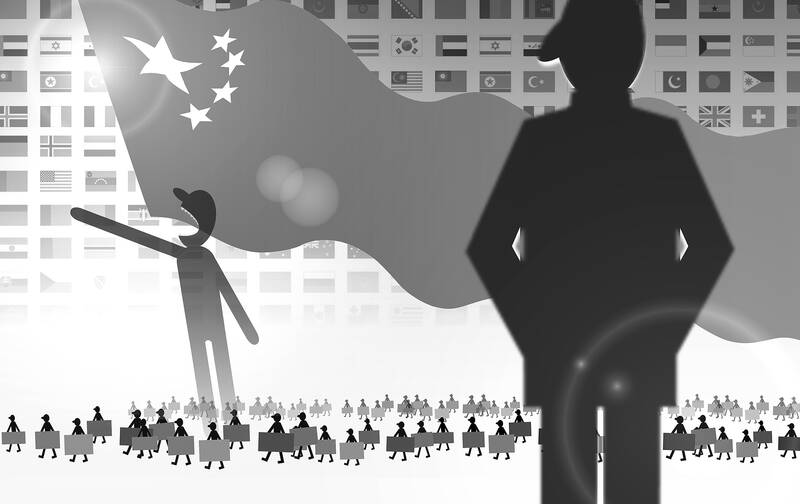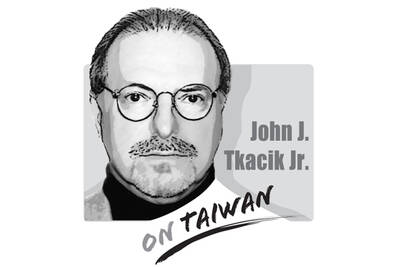China has taken an important symbolic step toward addressing a persistent drag on its economy. Much attention has been focused on the cost that US President Donald Trump’s tariffs would inflict, the mounting toll of a real-estate crisis, and even the long-term impact of a shrinking labor market. It has been easy to forget that Beijing has an inflation problem.
Not the surging — and now receding — prices that just about every other economy has wrestled with. Instead, Beijing is haunted by the specter of deflation. Chinese Premier Li Qiang (李強) told legislators gathered on Wednesday last week at the National People’s Congress that he would target inflation of 2 percent this year, the lowest level in more than two decades. That might not sound like a big breakthrough, given most countries aim for something in that vicinity, and Li’s ambitions to boost government and consumer spending. However, the first stage in solving any problem is acknowledging there is an issue in the first place.
Rock-bottom inflation had faded from the radar as a hurdle for China. Gaming out what Trump’s return to the White House means for everything, from Russia’s invasion of Ukraine to Chinese President Xi Jinping’s (習近平) plans to bring Taiwan to heel, has clogged the airwaves. Happily, the premier has put the issue back in the spotlight.

Illustration: Yusha
Just as important as the desired level of inflation is the contrast with the objective in the past. The longtime aspiration was for 3 percent, a level that is plainly out of reach. Consumer prices rose just 0.5 percent in January from a year earlier and, aside from a brief period in 2022, they have not gained at a 2 percent clip since the first months of the COVID-19 pandemic. That kind of pace is also unlikely to be met this year; it would take a stellar revival in the domestic economy to get there. The point is the gap between reality and aspiration.
The shift encourages policymakers, in theory, to do something to meet the new number. When authorities around the world began to adopt targets in response to politically bestowed mandates for price stability, the idea was that actions would be geared to their pursuit. In many instances, that meant freeing central banks to raise interest rates long enough to grind the consumer price index down. The institutions were mostly granted independence alongside those goals. That was predominantly a 1990s story and the notion that inflation would slip far below those targets was barely considered. That changed with the subprime crisis a decade later, its aftermath and then the early stages of the COVID-19 pandemic. It was not until after inflation quickened in late 2021 that borrowing costs were jacked up.
China had a different story then — and does now. Little in the country is truly independent of the Chinese Communist Party or beyond Xi’s personal reach. The People’s Bank of China (PBOC) answers to politicians, and top officials tend to be party cadres. However, the PBOC is the central bank of the world’s second-largest commercial power, so its views and operational priorities do count for something. Global audiences do not hang on the words of PBOC Governor Pan Gongsheng (潘功勝) the way they do those of US Federal Reserve Chair Jerome Powell or Bank of Japan Governor Kazuo Ueda, but nor do they tune Pan out. They certainly do not ignore what Xi or Li say on the economy. The message from the latter is “loud and clear” and goals “will require considerable policy support to achieve,” Bloomberg Economics said.
As a practical matter, what can Beijing do? In the past, inflation goals announced at party conferences have tended to be regarded as ceilings rather than firm targets. The standard tools, such as rate cuts and relaxing reserve requirements have already been deployed, although in a modest manner. Monetary easing tends to weaken a currency and officials are reluctant to let the yuan slide quickly; the PBOC has enormous influence over the yuan’s movements on a daily, weekly and monthly basis. It is down 3 percent over the past 12 months. Fiscal levers have a big role to play.
Is there anything magical about 2 percent? When the US Federal Open Market Committee debated whether to adopt a formal target in the mid-1990s, then-Fed chairman Alan Greenspan had reservations. He fretted that announcing a hard target would tie the chair’s hands, robbing him and his successors of discretion when it was most needed. He jousted with Janet Yellen, then a Fed governor, about what level of inflation would be most consistent with price stability. They coalesced at about 2 percent, a figure that was popular with monetary thinkers at the time. Critically, the Fed held back from enshrining that as a long-term objective until long after Greenspan departed. It was a very big moment in the annals of central banking.
Can Chinese policy rise to the moment? Skepticism is certainly warranted, but here is hoping words count for something.
Daniel Moss is a Bloomberg Opinion columnist covering Asian economies. Previously, he was executive editor for economics at Bloomberg News.

On May 7, 1971, Henry Kissinger planned his first, ultra-secret mission to China and pondered whether it would be better to meet his Chinese interlocutors “in Pakistan where the Pakistanis would tape the meeting — or in China where the Chinese would do the taping.” After a flicker of thought, he decided to have the Chinese do all the tape recording, translating and transcribing. Fortuitously, historians have several thousand pages of verbatim texts of Dr. Kissinger’s negotiations with his Chinese counterparts. Paradoxically, behind the scenes, Chinese stenographers prepared verbatim English language typescripts faster than they could translate and type them
More than 30 years ago when I immigrated to the US, applied for citizenship and took the 100-question civics test, the one part of the naturalization process that left the deepest impression on me was one question on the N-400 form, which asked: “Have you ever been a member of, involved in or in any way associated with any communist or totalitarian party anywhere in the world?” Answering “yes” could lead to the rejection of your application. Some people might try their luck and lie, but if exposed, the consequences could be much worse — a person could be fined,
Xiaomi Corp founder Lei Jun (雷軍) on May 22 made a high-profile announcement, giving online viewers a sneak peek at the company’s first 3-nanometer mobile processor — the Xring O1 chip — and saying it is a breakthrough in China’s chip design history. Although Xiaomi might be capable of designing chips, it lacks the ability to manufacture them. No matter how beautifully planned the blueprints are, if they cannot be mass-produced, they are nothing more than drawings on paper. The truth is that China’s chipmaking efforts are still heavily reliant on the free world — particularly on Taiwan Semiconductor Manufacturing
On May 13, the Legislative Yuan passed an amendment to Article 6 of the Nuclear Reactor Facilities Regulation Act (核子反應器設施管制法) that would extend the life of nuclear reactors from 40 to 60 years, thereby providing a legal basis for the extension or reactivation of nuclear power plants. On May 20, Chinese Nationalist Party (KMT) and Taiwan People’s Party (TPP) legislators used their numerical advantage to pass the TPP caucus’ proposal for a public referendum that would determine whether the Ma-anshan Nuclear Power Plant should resume operations, provided it is deemed safe by the authorities. The Central Election Commission (CEC) has